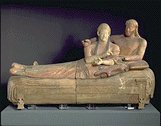The minoans of ancient Crete were great record keepers, although more substantial evidence of their culture has proved elusive, limited to excavations of palaces. The palace of minos, when excavated, revealed a mighty stone throne, proving that Europeans have been using chairs for 4,000 years.

The Greek House
The average Athenian male spent very little time at home, but devoted his attentions to civic activities at the Agora, religious commitments, and the Gymnasium. As a result, there was not a great need for general furniture or fitted furniture.
A typical house consisted of two pillared courts - the andronitis, or men's apartment, and the gynaeconitis, or women's apartment, which was used as a general living room.
Surrounding these courts were small cells used as sleeping quarters. The most important furnishings were the hearth, at which offerings were made to the goddess Hestia, and an altar to Zeus.
Seating antique furniture, tables, and beds were predominantly from wood - our knowledge of them is limited to depictions on vases, carvings and paintings.
Ancient and enduring models
The diphros okladias was a direct appropriation of the Egyptian X-frame stool, and was certainly in use as long ago as the Aegean period.
A more original Greek stool design was the bathros, consisting of a flat, square top supported on four legs. Similarly the Greeks made use of Egyptian style chairs for many years until they developed the klismos, a design of extraordinary longevity that is still encountered to this day.
Regarded by the Greeks as a feminine piece of furniture, the klismos has four curved legs that bend under the seat of the chair before sweeping back outwards as they reach the floor.

The shaped back, called a stile, displays an awareness of ergonomics. There is evidence that the ancient Greeks also used stools that were specifically designed to support infants.
Tables were usually constructed with three legs to aid balance on the uneven earth or plaster floors of the Greek home. The Greek word kline, root of the English "recline", was used to describe both beds and couches, which were used while eating.
The poor made their beds on the ground, while wealthier Greeks had wooden, bronze or ivory bedsteads on which they arranged animal skins, woollen cloths and linen.
Kline were raised on legs at a height that allowed the occupant to reach the dining table. A number of these couches would be present in the andron, or dining room, of the richest Greeks. Some were constructed from valuable imported wood, or decorated with marquetry designs or precious metal inlays.
The furniture, now original antiques or reproduction furniture, of Etruria is known only through excavation, as no Etruscan texts survive. Immigrants attracted to the area bought with them knowledge from the flowering civilizations of Greece, Egypt and Asia Minor.
Forms from all over the ancient world, such as the Egyptian X-chair and the Greek kline, thus found their way to the Italian peninsula before the advent of the Roman Empire.
Wardrobes Bowen hills
ReplyDelete